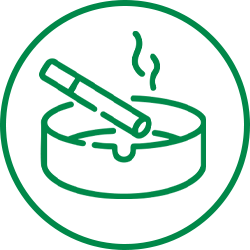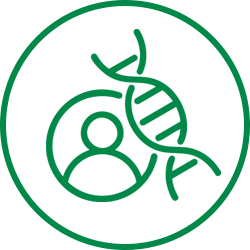November is Lung Cancer
Awareness Month
Why it matters
Lung cancer is the number one cause of cancer deaths, accounting for about 1 in 5—more than colon, breast, and prostate cancers combined.[1] It’s also the second most common diagnosis, behind only prostate cancer for men and breast cancer for women.[2]
While smoking is the most significant risk factor, lung cancer can affect everyone—even if you don’t regularly use tobacco. In recognition of Lung Cancer Awareness Month, here’s what you should know and do to keep your lungs breathing easy for years to come.
Upcoming Webinar
Join John Muir Health on Thurs., Nov. 13 at 10:30am PT/1:30pm ET to hear from Dr. Michaela Straznicka, a cardiothoracic surgeon who will cover:
- Lung cancer basics
- Signs and symptoms
- Why screening matters
Key risk factors

Tobacco use
Smoking is responsible for 80–90% of lung cancer deaths, and people who smoke cigarettes are 15-30 times more likely to get or die from lung cancer.[3] Even occasional smoking or secondhand smoke exposure increases risk.

Environment and job-related clothing exposure
Exposure to certain chemicals and pollutants also increases your risk, including:
- Radon—a colorless, odorless radioactive gas found in soil and homes. Radon exposure is the second-leading cause of lung cancer in the U.S.
- Asbestos—common in older building materials
- Air pollution—both indoors and outdoors
- Other hazardous chemicals found in certain industrial environments—arsenic diesel exhaust, chromium and silica

Family history
If lung cancer runs in your family, discuss screening options with your primary care provider (PCP).
Ready. Set. Screen. for early detection
Lung cancer often develops silently, with symptoms appearing only in advanced stages. Screening is critical for individuals who:
- Are age 50+
- Have a history of 20+ pack-years or more (see explanation)
- Quit smoking within the past 15 years
A Low-Dose CT (LDCT) scan is the recommended screening. While this may feel scary, early detection dramatically improves survival rates. If you have a persistent cough, chest pain, shortness of breath or cough up blood, see a doctor immediately.
What is a pack-year?
Multiply the number of packs smoked per day by the number of years smoked.
For example:
- 2 packs a day for 10 years: 2×10 = 20 pack-years
- 1 pack a day for 20 years: 1×20 = 20 pack-years
Treatment options
If you or a loved one is diagnosed with lung cancer, your treatment options depend on the type and stage:
- Surgery is often used for early-stage non-small cell lung cancer (NSCLC)
- Radiation therapy uses high-energy rays to kill cancer cells
- Chemotherapy uses drugs to target and kill cancer cells throughout the body
- Targeted therapy & immunotherapy involve advanced treatments that block cancer growth or boost the immune systems
Many patients receive a mix of treatments to ensure the best possible outcome.

Support and prevention
If you use tobacco, quitting is the most effective way to reduce your risk of lung cancer. Here are some support options:
- All Clorox teammates can access tobacco cessation coaching through Personify Health. Visit join.personifyhealth.com/clorox (use passphrase: WellnessYourWay$) and follow this path: Health > Coaching > Connect with a Health > Be Tobacco Free.
- Teammates enrolled in the Kaiser medical plan have access to an additional tobacco cessation program.
- Talk to your PCP during your next well visit to learn the best options to help you quit or screen for lung cancer.
- Reduce environmental risks: Test your home for radon, avoid asbestos exposure and minimize exposure to air pollution when possible.
Supporting your wellness journey
Even if lung cancer isn’t top of mind for you, your health and well-being still should be. Remember these programs available to help you:
- No-cost in-network preventive care through Clorox’s medical coverage
- Cash payouts through Hospital Indemnity and Critical Illness coverage when you receive a routine preventive exam
- Up to $400 in Rewards Cash annually ($100 per quarter) through Personify Health
- No-cost mental health support through Spring Health
For more information about Clorox’s preventive care resources and programs, click here.
[1] American Cancer Society
[2] National Cancer Institute
[3] Centers for Disease Control and Prevention (CDC)